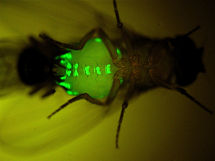Pheromones may not initiate sexual attraction and mating, as commonly believed, new research suggests. Instead, the chemical signals may help flies distinguish between different genders and species while choosing a mate, researchers linkurl:report;http://www.nature.com/nature/index.html in this week's issue of Nature.
"This is the first time a study has deciphered the chemical dialogue happening between flies as they mate," said linkurl:Nicolas Gompel,;http://www.ibdml.univ-mrs.fr/equipes/BP_NG/Nicolas%20Gompel's%20page.html a geneticist at the Institut de Biologie du Developpement de Marseille-Luminy in France, who was not involved with the research but wrote an accompanying commentary on the paper. "The research challenges the common belief that pheromones are essential to initiate courtship... and suggests that instead, [they] play a significant role in mate identification and selection." Scientists have long understood that pheromones, hydrocarbons...
 |
produce pheromones are located in the abdomen. These 'oenocytes' are revealed by expression of a protein fluorescing green. Image: Jean-Christophe Billeter |
Drosophila melanogaster
D. melanogasterD. melanogasterD. simulansD. yakubaD. melanogasterUAS-tra
Interested in reading more?
Become a Member of
Receive full access to more than 35 years of archives, as well as TS Digest, digital editions of The Scientist, feature stories, and much more!
Already a member?



